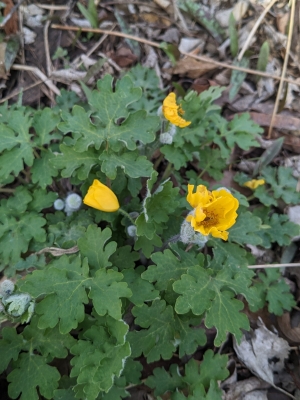What Are Native Spring Ephemerals?
Native spring ephemerals are a diverse group of herbaceous plants that emerge and bloom in the early spring, typically from March to May, in temperate regions like Virginia. After lying dormant underground throughout the winter months, these plants seize the opportunity presented by increasing temperatures and ample moisture to send up delicate shoots and unfurl their blooms. Their above-ground growth phase is brief but intense, as they race to complete their life cycle before the canopy trees leaf out and cast the forest floor into shade. Once they have finished flowering and setting seed, usually within a few weeks, they retreat back into dormancy for the rest of the year. This ephemeral nature is a key defining trait, lending them their name.
 These ephemerals encompass a wide array of species, many of which can be seen in the woodland portion of the Native Plant Trail at Blandy. During an early spring stroll through the woodland, you may see Bloodroot (Sanguinaria canadensis), Virginia Bluebells (Mertensia virginica), Toadshade Trillium (Trillium sessile), Wood Poppies (Stylophotum diphyllum), Rue-anemone (Thalictrum thalictroides), Largeflower Bellwort (U vularia grandiflora) and Jacobs Ladder (Polemonium reptans), among other species. Each brings its own unique charm and beauty to the springtime landscape.
These ephemerals encompass a wide array of species, many of which can be seen in the woodland portion of the Native Plant Trail at Blandy. During an early spring stroll through the woodland, you may see Bloodroot (Sanguinaria canadensis), Virginia Bluebells (Mertensia virginica), Toadshade Trillium (Trillium sessile), Wood Poppies (Stylophotum diphyllum), Rue-anemone (Thalictrum thalictroides), Largeflower Bellwort (U vularia grandiflora) and Jacobs Ladder (Polemonium reptans), among other species. Each brings its own unique charm and beauty to the springtime landscape.
Ecological Importance of Spring Ephemerals
While their fleeting appearance may seem inconsequential, native spring ephemerals play a crucial role in the ecology of Virginia's forests and woodlands.
Early Pollinator Resources: As some of the first plants to bloom in the spring, ephemerals provide vital nectar and pollen resources for early-emerging pollinators such as bees, flies, and butterflies. In doing so, they support the health and diversity of local pollinator populations.
Soil Health and Nutrient Cycling: The roots of spring ephemerals penetrate deep into the soil, helping to improve its structure and fertility. As these plants senesce and decompose after flowering, they return nutrients to the soil, enriching it for other plant species.
Biodiversity and Habitat Support: Ephemerals contribute to the overall biodiversity of forest ecosystems, providing habitat and food sources for a variety of wildlife, including insects, birds, and small mammals.
Indicator Species: The presence or absence of certain spring ephemerals can serve as indicators of environmental health and habitat quality. Monitoring these species can provide valuable insights into the condition of forest ecosystems and the impacts of human activities such as land development and climate change.
 Conservation and Appreciation
Conservation and Appreciation
Despite their ecological importance and aesthetic appeal, native spring ephemerals face threats from habitat loss, invasive species, and unsustainable harvesting. Conservation efforts aimed at protecting these delicate plants and their habitats are crucial for ensuring their continued presence in Virginia's natural landscapes. As nature enthusiasts and stewards of the environment, it is incumbent upon us to appreciate and safeguard these ephemeral treasures. By supporting local conservation initiatives, practicing responsible land management, and cultivating native plant gardens, we can help preserve the beauty and biodiversity of Virginia's springtime woodlands for generations to come.
Planning to visit the Native Plant Trail Woodland this spring? Check out our brochure for a field guide to common wildflower species.

